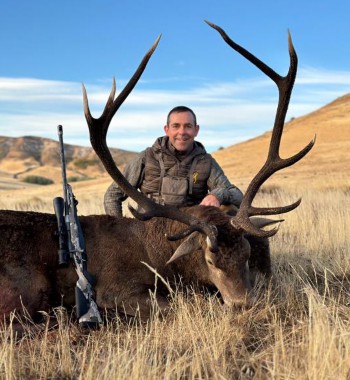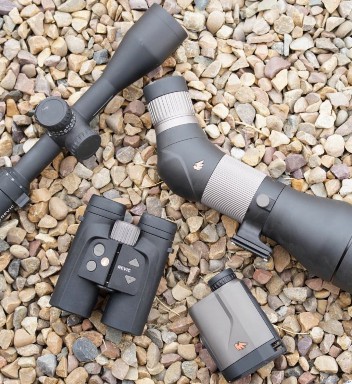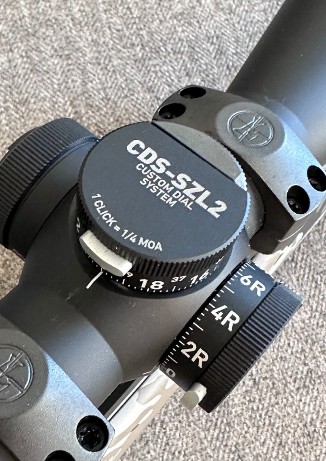Hunting Optic Innovations That are Worth the Look
Technology Can Simplify Our Hunts
By Andrew McKean
Swarovski’s EL Range is a true hunter’s device. The emphasis is on best-in-class glass, a clear and simple red LED ranging reticle and simple tech that won’t overwhelm you during a hectic lead-up to a must-make shot.
For a man of a certain age, I’m fairly handy with my smartphone. I’m not saying my kids ever come to me for technical advice, but I can operate a digital camera and navigate most mobile apps with the best of my cassette and VCR generation.
But some of the ballistics software and operations of the newest generation of “smart” optics have me flummoxed.
When it comes to things like importing ballistics data, like muzzle velocity, into these devices and then figuring out the right drag value to use in the ballistic coefficient entries to understanding how to recognize and apply wind values, there’s more calculus and trigonometry required to properly use some devices than you’d need for a passing grade in a college-level math course.
Happily, there’s a class of optics that uses just enough tech to make you a better, more informed and effective hunter. And they won’t bog you down in cosines, secants and drag coefficients on glitchy, headache-inducing digital screens.
Some of these advances that I’ve found are not digital at all. Rather, they include new materials and technologies that push the ancient craft of optics into the next generation.
I’ve spent months in the field with the most recent optics and can report that most of what I’d call “semi-smart” optics are worth the investment of money and time to learn.
Consider these new tech tools. Get familiar with them on the range and apply them during your future hunts.
RANGE-FINDING BINOS MADE FOR HUNTERS

Electro-optics pack digital technology into conventional sports optics. The rising trend in this segment has its most robust expression in range-finding binoculars. Powerful laser rangefinders are added to conventional binos to retrieve distances quickly.
The pinnacle expression of this trend might be SIG Sauer’s KILO10K, which has a digital heads-up display that’s equal to a fighter pilot’s visage and incorporates an astounding amount of ballistic data in precise distance-adjusted aiming solutions.
Another option is Swarovski’s laser range-finding binoculars. They simplify the data dump just enough to give users a clear and simple range. You can decide whether you want a line-of-sight distance or an angle-adjusted distance. And you decide if it’s the right amount of ballistics data you need to make an informed shot without being overwhelmed by variables.
It’s a true hunter’s device, with an emphasis on best-in-class glass, a clear and simple red LED ranging reticle, and simple, useful tech that won’t overwhelm a hunter in the hectic lead-up to a must-make shot.
Add wonderful ergonomics and a simple interface that’s easy to program through a mobile app. Relax. If that sounds complicated, it’s the same process you use to connect your phone to a rental car.
I used the 10×32 version of the EL Range on a Patagonia stag hunt, and before taking the field, I tuned the device to the ballistics of my Browning .300 Win. Mag. and 180-grain bullet.
My binoculars gave me the angle-adjusted range. But more importantly, the number of clicks I needed to enter into my Swarovski Z6 scope’s elevation turret to make a long and difficult shot across open country on a trophy-class, free-range stag.
I ranged, dialed, shot and celebrated. It’s hard to beat that progression of applied technology.
HANDLING VARIABLES FOR YOU

Revic’s opti-tech talents go way beyond its first “smart scope,” a heavy but genius precision scope with a digital elevation turret and built-in weather system that turned my 800-yard rifle into a 1,500-yard rifle.
Revic is a Wyoming company and the optics arm of the semi-custom gunmaker Gunwerks. They now have a rangefinding monocular and binocular, as well as a precise Acura spotting scope. The Acura has an integrated reticle.
The components work best in tandem. Range a target with the rangefinder. Then, follow the prompts in the display that indicate what to dial the riflescope to for distance and wind. Get your buddy to call your shots through the spotting scope. Conveniently, the spotter uses the same reticle as the rifle scope, so you’re speaking the same ballistics language.
Revic is among a handful of companies — SIG’s BDX system is another — whose families of optics have stretched our expectations of long-range hunting and shooting. Used to be, a 400-yard hunting shot was the limit of our gear. Now, hunters are often comfortable nearly doubling that distance, assuming all conditions are correct. And long-range precision target shooters routinely make consecutive mile-long shots with integrated optics like Revic’s.
ELIMINATING THE SHAKES

Given the proliferation of digital screens in traditional optics, it’s refreshing to see Sig Sauer’s pursuit of a different sort of electro-optics. The brand has invested heavily in its stabilized ZULU 6 binocular line. The outcome is ownership of a surprising vacant niche: high-magnification hand-held binoculars.
Conventional wisdom has held that binoculars with more than 10- or 12-power are hard to use without a tripod. The small shakes of the user’s hands impart vibration to the image delivered by the binocular, making hand-held viewing fuzzy.
But the ZULU 6 employs an onboard gyroscope that cancels those shakes, steadies the image and enables users to employ more magnification without a tripod or other support.
The result is that hunters can hand-hold 12-power, 15-power and even 18-power binoculars, giving them much more reach without worrying about distracting movement. It’s the perfect bridge between traditional 8- and 10-power binoculars and lower-magnification spotting scopes.
The practical advantage is that users of the ZULU 6, mainly Coues’ deer, mountain sheep, and open-country mule deer hunters, can carry less gear in the field but have all the game-spotting advantages of high-mag binoculars.
DIALING MADE EASY

As a cook, I’ve incorporated the mantra “delicious meals begin with delicious ingredients.” The same can be said of ballistics information. The outcome, in terms of ballistics-corrected aiming solutions, depends entirely on the inputs. That’s the key to unlocking the capabilities of custom ballistic turrets: Leupold’s Custom Dial System (CDS) dials the first among equals.
You will need to spend time collecting and inputting precise muzzle velocities and spend even more time with the ballistic coefficients of your bullet as well as things like the barometric pressure, elevation and expected temperature where you intend to hunt. The more precise your ingredients, the tastier your results.
The elements that separate Leupold’s CDS dials from the competition are the precision engraving of the turrets, the bold indexing that allows users to see at a glance the setting and the locking mechanism that prevents these custom dials from inadvertently turning in the field.
Leupold’s new VX-6HD Gen 2 scopes improve on the originals. They now have locking turrets, with tool-less removability and two free custom dials.
When the inputs are right, the range is correct, and the rest is solid, making first-shot hits is as simple as ranging, dialing the CDS to distance and firing.
Trijicon brought Low-Power Variable Optics from the battlefield to the field. Hunters have realized that having a no-magnification scope with some zoom is highly versatile for all kinds of hunting.
LOW-POWER VARIABLES COME OF AGE
It’s a stretch to credit a single brand with creating an entire category of optics, but most LPVOs, Low-Power Variable Optics, can trace their origins to Trijicon’s handy, versatile 1-6×24 rifle scopes.
These scopes first came to prominence as AR carbine optics, configured for close-quarters combat and mid-range engagement.
Their talents as dangerous game scopes and durable optics for turkey shotguns, muzzleloaders and straight-wall cartridge carbines have elevated this category out of the battlefield and into just about every other field.
LPVO’s start at 1x, that is, no magnification, and often go out to as much as 10x. They have an illuminated red dot.
And, in first-plane reticle configurations, they are serviceable red-dot scopes at low magnifications and extremely useful precision optics at higher magnifications.
On a flat-shooting 6mm ARC, my 1-8×28 Trijicon Credo has become my go-to coyote scope, allowing me to engage in-your-face coyotes when they commit and to hold for going-away coyotes with the MIL-based tactical reticle when they don’t.
I just added a Credo HX 1-6×24 to my 350 Legend straight-wall carbine for the ultimate big-woods deer rig.
STEEPER LEARNING CURVE YET ENGAGING
Any discussion of applied optical technology has to include the fastest-growing, most energetic category of optics: thermal devices. These entirely digital products — including hand-held monocular viewers and weapon-mounted sights — use special lenses and software to convert small variations in a target’s temperature to a visual representation.
If that sounds next-level, it is, but for wildlife viewers and hunters, all you need to know is that they enable you to literally see in the dark.
Thermals got their foothold with Texas hog hunters, but they’ve become essential gear for coyote hunters everywhere.
They’re not for everyone. For starters, they’re expensive — the best scopes, like Pulsar’s Thermion 2, can cost upwards of $5,000. And their learning curve is steep, especially for users who struggle to navigate their smartphones. But if you invest a little time, patience and deep study of the user manual, they open a world of opportunity for hunting and wildlife viewing once the sun sets.
Just as with daylight optics, you get what you pay for, so buy the best thermal you can afford. A good choice is Pulsar’s Axion 2 LRF, which has a powerful thermal core, connects to your smartphone so you can share videos and photos, and a built-in laser rangefinder so you can tell if that distant nocturnal image is a house cat or a mountain lion.

